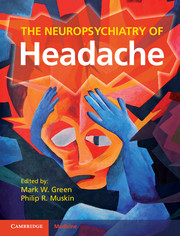Crossref Citations
This Book has been
cited by the following publications. This list is generated based on data provided by Crossref.
2013.
New Books.
Focus on Alternative and Complementary Therapies,
Vol. 18,
Issue. 2,
Spierings, Egilius L.H.
2014.
Review of The Neuropsychiatry of Headache.
Headache: The Journal of Head and Face Pain,
Vol. 54,
Issue. 1,
p.
195.
Vodička, Michal
2016.
Liaison psychiatry.
Psychiatrie pro praxi,
Vol. 17,
Issue. E-verze 3/16,
p.
e25.
Golovacheva, V. A.
Parfenov, V. A.
Tabeeva, G. R.
Osipova, V. V.
Smulevich, A. B.
Andrushchenko, A. V.
and
Golovacheva, A. A.
2017.
The optimization of management of chronic daily headache patients.
Zhurnal nevrologii i psikhiatrii im. S.S. Korsakova,
Vol. 117,
Issue. 2,
p.
4.
Golovacheva, V.A.
and
Parfenov, V.A.
2019.
Cognitive behavioural therapy in the treatment of chronic daily headache .
Annals of Clinical and Experimental Neurology,
Vol. 13,
Issue. 4,
Golovacheva, V. A.
Golovacheva, A. A.
Parfenov, V. A.
Tabeeva, G. R.
Romanov, D. V.
Osipova, V. V.
and
Katsarava, Z.
2021.
Cognitive behavioral therapy in the treatment of chronic migraine: a clinical case report.
Neurology, Neuropsychiatry, Psychosomatics,
Vol. 13,
Issue. 1,
p.
74.
Golovacheva, Veronika A.
and
Golovacheva, Anzhelika A.
2021.
Treatment of chronic migraine and neck pain with cognitive-behavioral therapy. Case report.
Consilium Medicum,
Vol. 23,
Issue. 11,
p.
852.
Golovacheva, Veronika A.
Golovacheva, Anzhelika A.
and
Parfenov, Vladimir A.
2021.
Chronic migraine treatment: multidisciplinary approach. Case report.
Terapevticheskii arkhiv,
Vol. 93,
Issue. 12,
p.
1528.
Golovacheva, V. А.
Golovacheva, А. А.
Volodarskaya, Е. А.
and
Bakhtadze, М. А.
2022.
Clinical and psychological characteristics of migraine patients.
Meditsinskiy sovet = Medical Council,
p.
78.
Richardson, Shannon
and
Diaz‐Orueta, Unai
2024.
In search of a neuropsychological profile for migraine: A scoping review.
European Journal of Pain,
Vol. 28,
Issue. 7,
p.
1033.



